For Super Sleuth DC Fans: An ongoing look at 86 years of DC Comics, beginning with New Fun #1, January 11, 1935 through March 1938.
Contributor Mini bios: William Merle Allison, William Henry Cook, Matt Curzon, Rolland Howard Livingstone, and John Francis Mahon
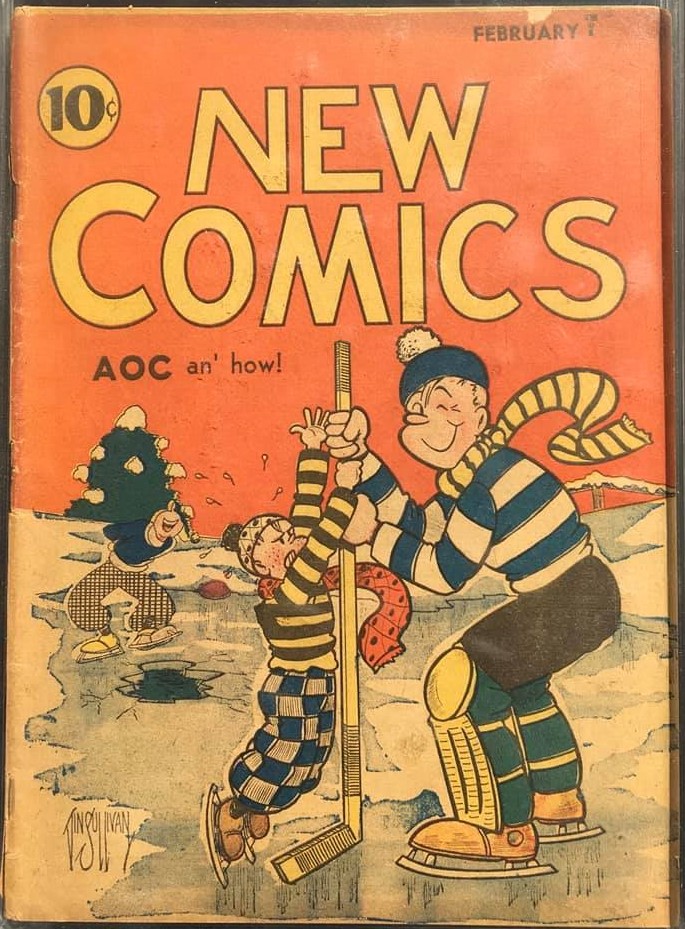
New Comics #3 is noteworthy for several reasons. It’s one of the first positions for Carson Smith McCullers, the great southern writer of novels such as The Heart Is A Lonely Hunter. Samuel M. Iger as “Maxwell,” one of the founding fathers of the comics industry had a one page of comic shorts and it was the last magazine for the Major with William Cook and John Mahon. They would go on to publish their own comics The Comics Magazine.

Cover by Vin Sullivan
My overall impression of New Comics #3 is that on the one hand the magazine seems to have hit its stride especially with the contributions of Vin Sullivan, Sheldon Mayer and Siegel and Shuster’s “Federal Men.” On the other hand, there is the sense that the magazine was struggling. There are several comics that seem last minute and not fully developed and several pages that come across as filler probably necessary to fill 64 pages. Given Cook and Mahon’s departure that would seem probable.
New Comics #3 appeared on newsstands February 1, 1936, 85 years ago. The cover is orange/red with large bold yellow NEW COMICS and underneath AOC an’ how! in bold black underneath. What is AOC you ask? According to the Editor’s note on the first page AOC stands for All Original Comics.
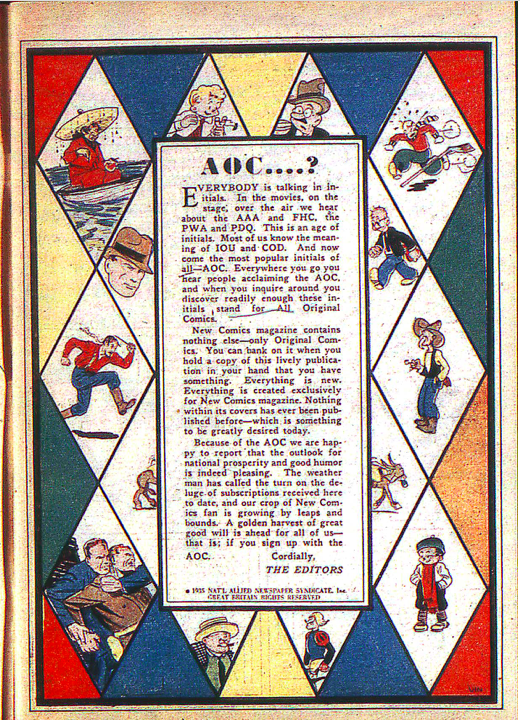
“New Comics magazine contains nothing else—Only Original Comics. You can bank on it when you hold a copy of this lively publication in your hand that you are getting something. Everything is new. Everything is created exclusively for New Comics magazine. Nothing within its covers has ever been published before—which is something to be greatly desired today.”
All original comics is obviously an important selling point. Even though there were all original comics magazines earlier, the Major’s comics were the only ones currently on the newsstands. Although some of the magazines contained a few original comics they consisted of mostly reprints from newspapers. He believed that all original comics was the way to go for comics magazines and he was more than proved right especially as other publishers began to follow his lead.
The cover art is by Vin Sullivan. The artwork is graphically simpler than the More Funs and grabs a potential reader’s attention. Sullivan’s character Jibby Jones is featured bullying a younger kid by being taller and able to reach higher on the hockey stick and thus call dibs. That theme might not read well in today’s climate. The SM distribution logo continues in the upper corner.

The inside cover features the masthead which is the same as More Fun #7 & 8, and New Comics #1 & 2 with Malcolm Wheeler-Nicholson as Editor and Publisher, William Cook as Managing Editor, John Mahon as Business Manager and Vincent A. Sullivan as Assistant Editor. Cook first appeared in New Fun #3 with a story, “The Magdelena Kid.” By New Fun #6, Cook was Managing Editor and in New Comics #1 John Mahon appeared on the masthead as Business Manager. When More Fun #9 was on newsstands March 5, 1936 they were no longer on the masthead and 10 days later they published The Comics Magazine which had a similar look and content to New Comics including some of the same artists and some of the Major’s material that appeared in both magazines. I’m not so sure that the simple explanation of the Major owed them money is accurate.
From what I’ve encountered so far, every comic book history maintains Cook and Mahon left the Major’s company “taking” a number of artists with them due to the Major’s poor business acumen. The supposition has always been that it had to do with payment of debts owed. The wording in these histories is always slanted with phrases like “fed-up” etc. The picture that comes to mind is a mass exodus of people running out the door. That’s not accurate and it’s not an even-handed look at the events.
As is usual with most events, it was more complicated. The artists weren’t necessarily in the office. Some of the artists were now involved with “shops” and it was more of a question of which “shops” were going with which magazine. I’ll get into that more in the next few postings.

David Saunders in his website Pulp Catalog notes a bankruptcy proceeding against Cook from The New York Times in December 19, 1935. Where was Cook getting the funds for the magazines if he was already in debt and in bankruptcy court? That doesn’t seem to be an auspicious beginning and doesn’t lend credence to his superiority in business management. Perhaps the funding was coming from Mahon’s contacts which prove to be noteworthy. Was it an attempt to undercut the Major? And if so, by whom?
I don’t doubt that MWN was struggling financially but the consistent denigration of his character does not fit with the larger view. MWN’s intention for his comics magazines was a huge stretch and he was one of a handful of founders who created an entire new industry during the Great Depression. Even Whitney Ellsworth who kowtowed to the company line, later stated in a letter to Jerry Bails, November 4, 1970—“Nicholson was a bit ahead of his time, and unfortunately the books did not prosper.” There’s much more to be said about that statement and we’ll get into it in later postings as well.
William Henry Cook, the Managing Editor, was born in Jersey City, New Jersey, October 8, 1888. He was 2 years older than the Major. Unlike some of the younger artists starting out, Cook’s involvement in the magazines was from a professional background in writing content for catalogues and according to the 1920 census as a “publicity clerk.” Cook sold his first pulp story to Ace-High Magazine in 1923 and continued writing for the pulps for 20 years. Most of his stories appeared in Sport Story Magazine and Fight Stories. His stories that appeared in the comics magazines are well-crafted but don’t have MWN’s level of creative skill. Most of the Major’s stories appeared in the better pulps such as Adventure and Argosy.
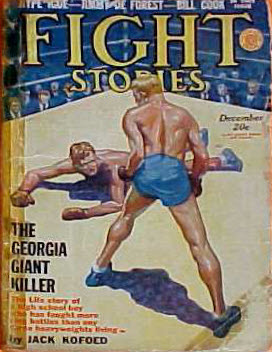
Fight Stories December 1930. Cover by Allan Thomas “From the Ringside” by Bill Cook“
The Mystery of the Gold Pieces” a short story by Wallace Kirk (William Cook) in New Comics #3 is an example. It’s a fairly simple well-written story but not particularly intriguing. The ending is disappointing as the bad guy turns out to be the poor janitor, a black man, who takes the rap for stealing the gold. It reads as derogatory to the character since there is no indication that the janitor had to be pretty clever to figure out how to steal the gold. There is an interesting line in the story: “Was it a ghost or the grim shadow of a superman that haunted the steel-clad of the State Line Bank?” Who knows whether this was in the zeitgeist or an awareness of Siegel and Shuster’s work in progress. And by the way, I’m calling Wallace Kirk as William Cook. The style of writing is the same and Wallace Kirk shows up immediately in The Comics Magazine with a new story. There is no one of that name to be found on any of the pulp lists as a writer.
Alex Jay in his excellent blog, “Tenth Letter of the Alphabet” notes an item that appeared in The New York Times March 25, 1929 in which Fiction House, Inc. bought Frontier Stories from Doubleday and that “William Henry Cook will be the new managing editor of the magazine…” That also indicates a solid background as a managing editor. It’s probable that Cook and MWN knew of one another through their similar publishing connections. MWN needed that kind of professional support especially at this juncture. Cook ultimately did not provide that support.

Cover by H. Crombie
John Francis Mahon was born in Shenandoah, Pennsylvania, October 28, 1897. He grew up in New Haven, Connecticut and by 1930 the family had moved to the Bronx. Mahon held a number of sales positions and then according to David Saunders went to work for Eastern Distributing Company. It was a small world indeed. The company was owned by Walter A. Angel and Paul Sampliner with whatever hand Harry Donenfeld had in the mix. It’s not clear how Mahon and Cook knew one another prior to their work for the Major since Mahon did not appear on the masthead of the Major’s magazines until December 1935 several months after Cook. My guess is that it was due to William J. Delaney, the new advertising manager and one of the characters from this era who keeps appearing in various parts of the story and probably manipulating events for financial reasons. It’s always about the money.
After leaving MWN’s company, Cook and Mahon started The Comics Magazine. Apparently, their combined business sense didn’t help in the face of the odds since their magazine was bought within several months by Ultem Publications with Harry Chesler as managing editor. Jay states in his blog posting on Cook: “The Comics Magazine Company’s last issues had the cover date June 1937. These issues appeared soon after this bankruptcy notice in the New York Times, February 6, 1937: William H. Cook, editor, 70 W. 11th St.—Liabilities, $16,486; no assets.” Why, only Cook and not Mahon?

Cover by Sheldon Mayer
From his 1942 WWII draft card Cook was unemployed and living in Sheffield, MA. So far there is no indication that Cook was involved in publishing after his last pulp story in 1943. William H. Cook died June 16, 1964 in Chester, Vermont. His story seems sad as he obviously had big ideas but wasn’t able to manifest them. My sense is that like the Major he may have been manipulated and used by others and then left to deal with the pieces on his own. That easily could have been the ending to the Major’s story but it wasn’t and therein lies the measure of the man.
Since Cook seemed to flounder after their comics magazine was bought out and Mahon appeared to continue working in the business side of publishing, it’s possible their connection was solely a business venture. There is little information about Mahon’s career after the 1940’s. Mahon listed his occupation as Magazine Publisher working on his own in the 1940 census. According to his 1942 draft card he was again employed by Five Star Publishing Company Inc. and further listed Larry Symonds, at the same address as someone who would always know his whereabouts. I’m interested in that connection to pulps and the distributors and will keep looking for more information. John Francis Mahon died in Shelton, CT in 1967.
Meanwhile the Major continued publishing his magazines, including in 1937 bringing out Detective Comics. Comparing the two, the Major’s magazines are of superior content and quality. In spite of the financial difficulties that he and others faced in attempting to publish original comics he held fast and continued to innovate. I’ll go into more depth with New Comics #4. There is much more to be gleaned from this episode.
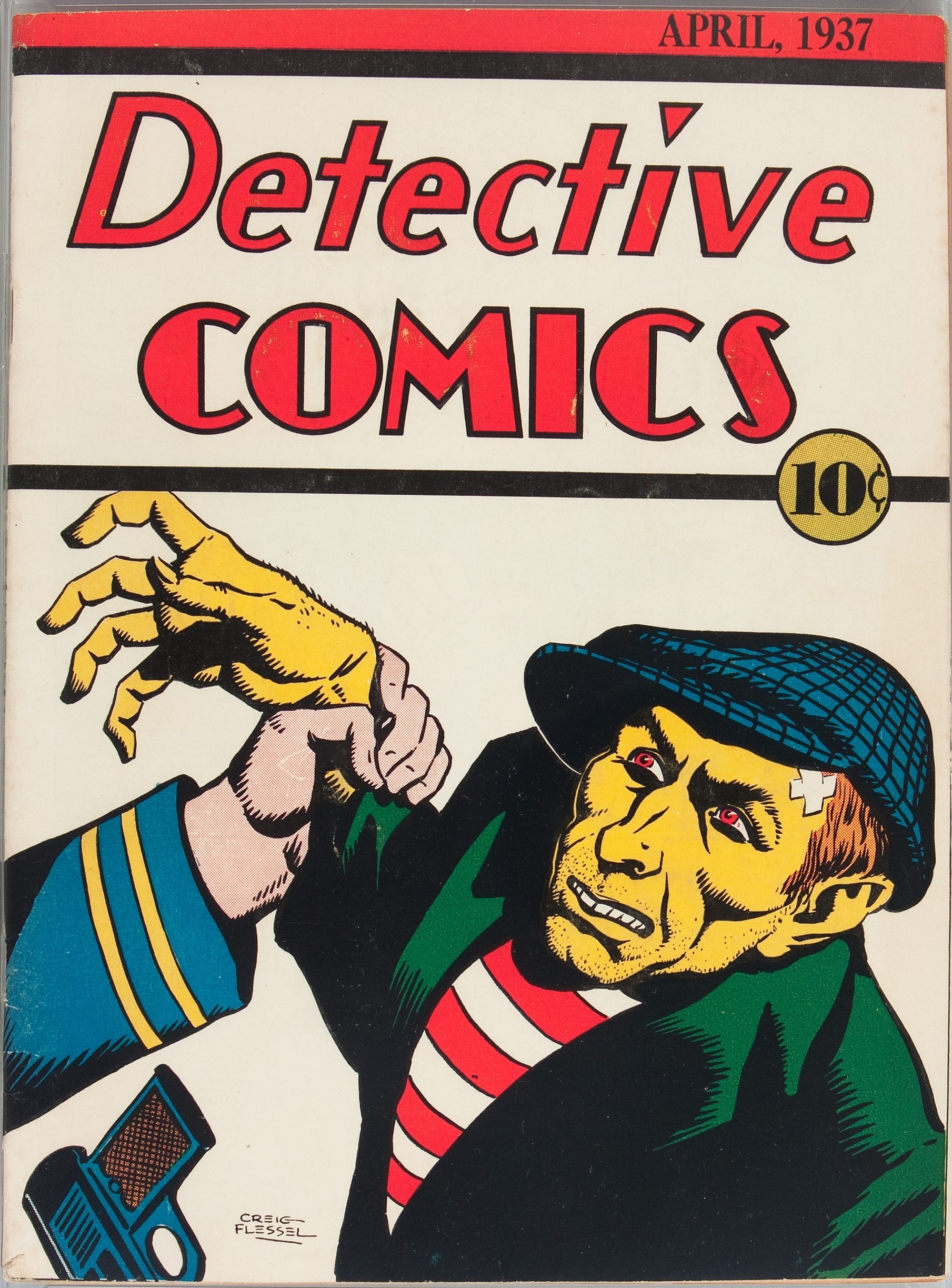
The first page of New Comics #3 is a message from the editor. It is multi-colored featuring different characters from the different comics. Vin Sullivan’s signature as “Vin” appears at the bottom right-hand corner. GCD (Grand Comics Database) concludes that Sullivan drew all the characters in the “style” of the other artists. If so, that signifies Sullivan’s first-rate ability as an artist.
“Copyright 1935 National Allied Newspaper Syndicate, Inc. Great Britain Rights Reserved” appears on every page.
The ad revenue is similar to the previous magazines. There are two large ads on the inside cover. The Gilbert Chemistry Set from Pastime Novelty suggests “Now is the time for a chemistry set. On the same page the Crowell Publishing Company is looking for boys to deliver magazines with prizes they can win. “This Bike can be Yours.” There is a one-half column ad for The House of Magic, A. G. Steen on the “It’s Magic” page and on the following page a small ad for Max Mehl coin dealer. A larger ad next to it from The Universal Toy & Novelty Mfg. Co. offers a special deal of novelties for readers of New Comics with the enticing “say, how’d you like a package of jimcracks.” According to Webster’s, Jimcracks (gimcracks) is an attractive bauble of little use. I wonder if the word had other meanings during that period. Presumably this ad would have only appeared in these magazines. A small ad on “The Radio Dialer” page from the Wilson Chemical Co. is too blurry to read but appears to ask for boys and men to deliver free samples. The Inside back cover has a large ad for The Pastime Novelty Company offering The Master Key and multiplying billiard balls. I have no idea why anyone would want multiplying billiard balls. The back-cover features Remington Typewriter. As noted in my post on More Fun #8, with William J. Delaney in charge of advertising, the large ads were likely placed in many magazines.
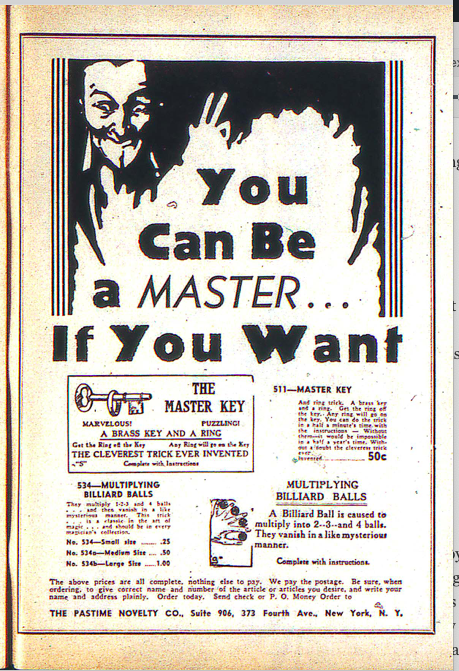
There are a couple of promotional ads for the magazines themselves. A large ad for More Fun suggests that “More than 500,000 people approve of this Ten Cent Magazine of Comics.” On the same page with the promotional offering of “jimcracks” from Universal Toy & Mfg. Co. is a large promotional ad for subscriptions to New Comics. The ad has a drawing by Bill Cook–nowhere near the skill of Dick Loederer. With every new subscription readers receive “a Novelty Painting Outfit, a Photo Album, Movie Star Photos, A packet of Rainbow Construction papers, A Magic Book, A packet of coloring Photos, a Story Book, Masks and a real fortune in play money.”
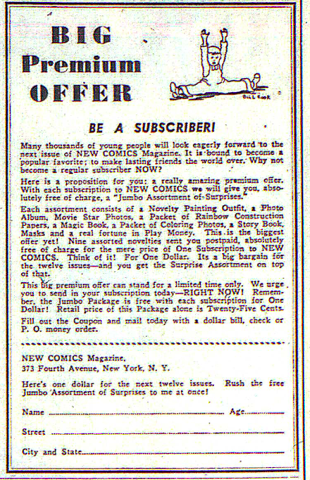
The first two-page comic, “Captain Bill of the Rangers,” is by W.M. Allison (William Merle) in color. It continues the story of Jim and Jane visiting their Uncle Bob out west. They recognize the train robber and go into town to tell Captain Bill. Mr. Lane from the ranch next door follows them into town, asks them to come visit his ranch and has his men kidnap them as they ride back to their Uncle Bob’s ranch. Allison’s artwork features strong line work and is appealing. It’s a well told adventure story reminiscent of the Hardy Boys, etc. from that time period. This was Allison’s last appearance in the Major’s magazines. The story continued in Cook and Mahon’s The Comics Magazine as “Captain Bill of the Rangers” for four pages. It did not appear in the 2nd issue of The Comics Magazine but returned for the next 3 issues as “The Further Adventures of Jane and Johnny.” The GCD refers to the strips in The Comics Magazine as “borrowed” from New Comics. I’m not sure what that means. Since the story continued in The Comics Magazine it doesn’t seem to be borrowed. Just to make things even more confusing, the story continued as Captain Jim of the Texas Rangers by Homer Fleming in New Comics #4.
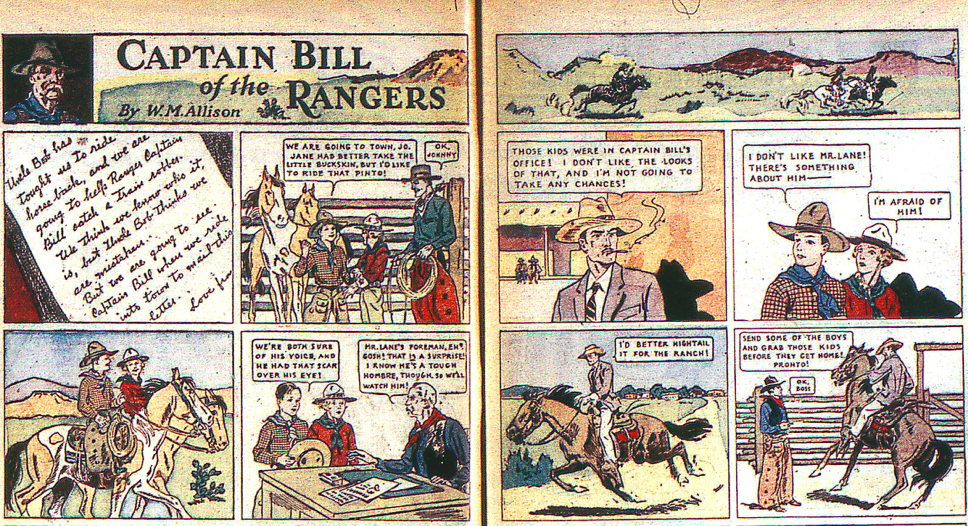
William Merle Allison was born January 27, 1880 in Ottawa, Kansas. He would have been about 55 years old in 1935 so hardly a newcomer. He had a long career in illustration for advertising, books and pulps. After studying at the John Herron Art Institute in Indianapolis and the Chicago Academy of Fine Arts, he and his widowed mother moved to New York City. Allison worked as an illustrator for advertising and illustrated a number of pulp magazines beginning in June 1917 until November 1940. Most of the pulps he illustrated were westerns. He began his work in comics in New Comics #2 and #3 for the Major and then went on to provide comics mostly of the western genre for a number of comics magazines for about 20 years. I love Allison’s artwork. It is superior in quality and he deserves more notice. Some of his western illustrations could easily be stand-alone paintings. William Merle Allison died in New York in 1964.
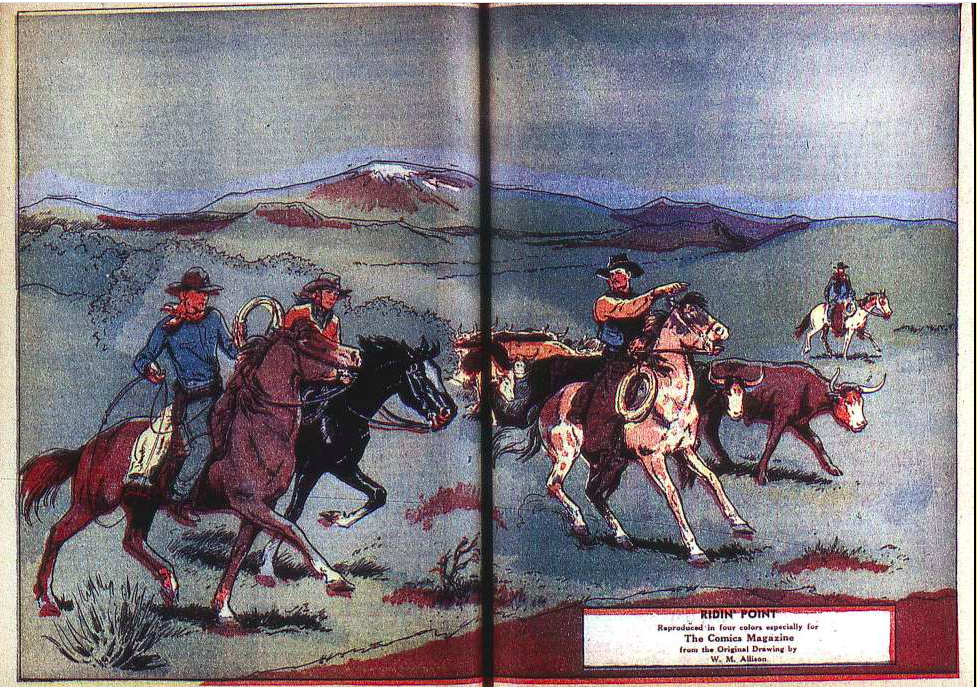
One of the mysteries I have been attempting to solve is finding the artist for the Tom Mix Ralston ads that appeared on the back covers of New Fun #1 and 2. Besides looking in the usual places I sent out several queries to supposed experts without luck. Just recently that information appeared on a couple of sites as William Merle Allison. I’m interested in the source of that information. However comparing the artwork, lettering, storyline and dialogue it seems pretty solid. The storyline for the ads is similar to the storyline for the comic strip and there are two children named Jimmy and Jane. That was probably Allison’s entrée to the magazines.
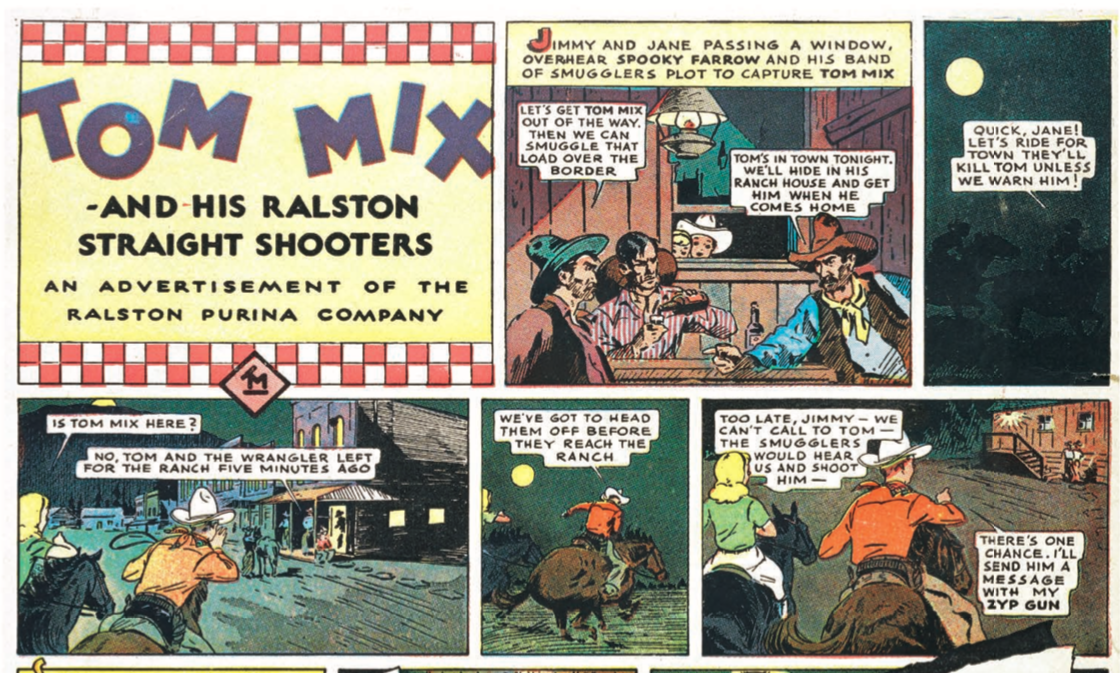
New Fun #1
R. G. Leffingwell had two continuing comics–“Sir Loin of Beef” and “Sagebrush and Cactus.” Both in color and both 2 pages each. Our characters Sir Loin and Cowhide attempt to nap after a hearty meal. Young Hash is annoyed as he wants to play. He finds some stones and with his slingshot continues to interrupt their naps. They tie him up and resume their nap. This comic seems aimed at younger children as the story is simple and rather silly. I’m not so sure that tying up young Hash would be acceptable today.
My favorite of Leffingwell’s comics “Sagebrush and Cactus,” is the continuing story of the gold miners–Sagebrush and Cactus. In this chapter they find the mine of gold, hide the entrance and head for town. The dialogue and illustrations provide a pretty good clue of what will happen and I look forward to the next installment. To leave a reader wanting more 85 years later firmly establishes Leffingwell’s skill as a comics artist. The artwork is solid and I love the wide-open spaces of the western scenes. The characters are strong and likeable and the story is interesting.
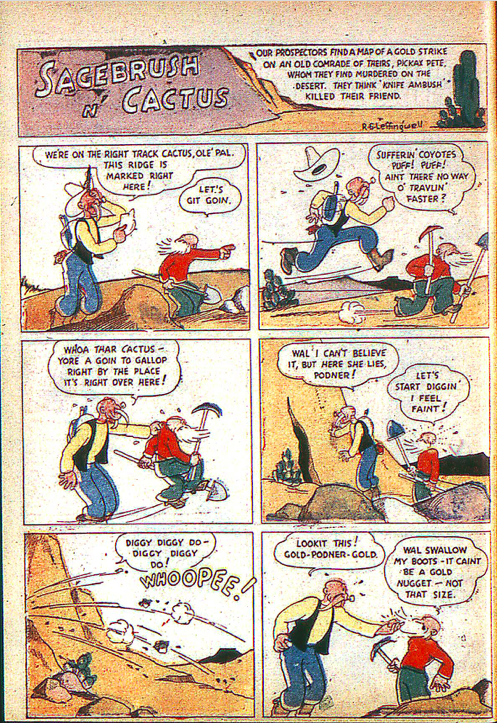
In addition, Leffingwell contributed a filler strip, in color, of “Fanny,” the mule, who has previously appeared in fillers and as a character in “Sagebrush and Cactus.” There is no dialogue. Fanny is hit on the head by an apple. She kicks the tree and another apple falls on her head. Her kicking ability figures in the plot of “Sagebrush n Cactus.”
Leffingwell also did the artwork for the ongoing reader activity, “It’s a Dern Lie” in color. Unlike previous stories there is no reader byline so the tall tale was probably written by him.
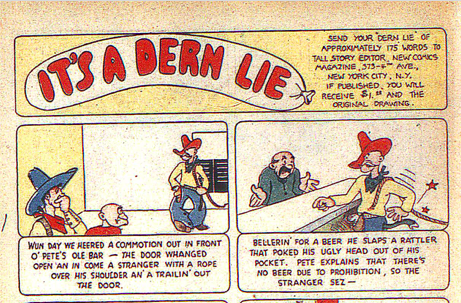
Besides acting as assistant editor, drawing the cover and the artwork for the editor’s page, Vin Sullivan had 3 comics and a one-page filler. “Jibby Jones” appears in a one-page comic in color. A bully is after Jibby because Jibby has called him a dope. He chases Jibby into a dead-end alley and plans to sock Jibby. The last panel shows the bully knocked out on the ground but it’s not clear what happened. The artwork continues to be solid.
“Beany” makes his second appearance in color in a two-page comic by Vin Sullivan. The character and storyline are similar to Jibby Jones. Beany gets into a fight with the local bully. He comes home and has to take a bath because his aunt is coming to visit. The bully and his henchman put a ladder against Beany’s house and throw rotten tomatoes at him after he is clean and dressed. Beany comes downstairs to meet his aunt covered in rotten tomatoes. The artwork is Sullivan’s usual high quality but the story is not all that interesting. Perhaps it was aimed for young children.
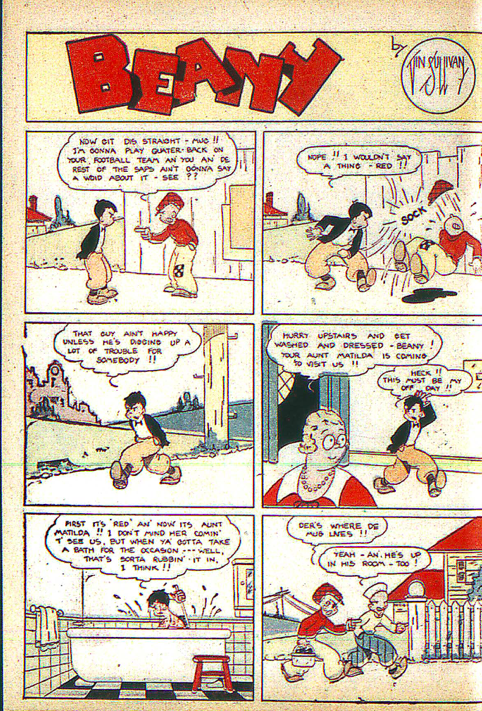
“Licorice” is a new character with a one-page comic in color by Vin Sullivan. The name of the character is bad enough and I’m sorry to say it is a negative stereotypical depiction of a young black child. It begins to rain and Licorice ends up in an enormous Mexican hat. Once it stops raining his friend asks him why he can’t take off the hat and he explains his clothes are drying.
Sullivan also has a full-page illustration in black and white for what would normally be a one panel cartoon. One of the characters looks similar to Jibby Jones and it’s a simple joke about a wishbone. The drawing looks unfinished and was one of the clues of the obvious need to fill pages.
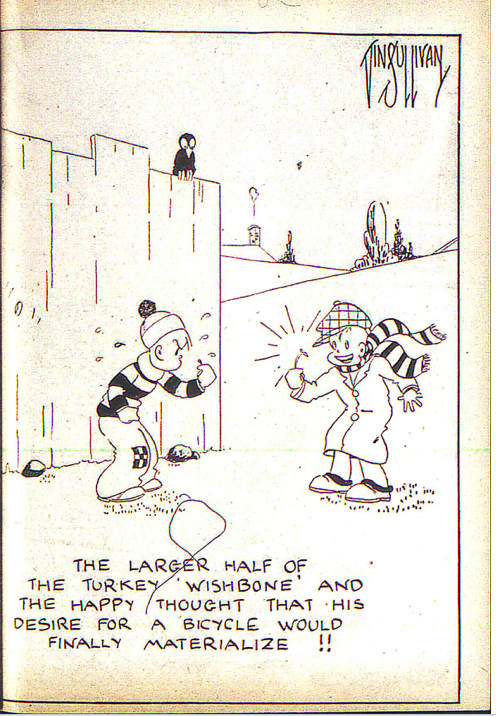
Whit Ellsworth has two comics, “Billy the Kid,” a continuing character and a new character “Dear Old Dad” that seems derivative of other comics of the period. In “Billy the Kid,” a one-page comic in color, Billy’s friend wants to play “Fencing” with wooden swords. Billy prefers fists. His friend keeps smacking him with the sword repeating “en garde” and “tooshay” until Billy punches him and yells Tooshay. Ellsworth’s draftsmanship is good but doesn’t particularly stand out and his storylines are not that interesting. Perhaps these were also aimed at younger kids.
“Dear Old Dad” by Whit is a one-page comic in color. This storyline has a more solid joke. Dad leaves exploding cigars on his desk because someone has been taking his. The boss and a new client help themselves with the unsurprising results. In the last panel Dad is seen at the Employment office.
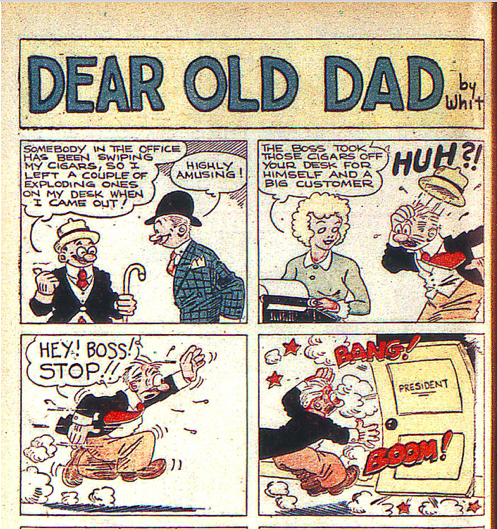
Ellsworth also had what was probably another filler in a two-page feature in color, “The Circus is Coming” by Whit Ellsworth consisting of two pages of one panel jokes about the circus and the various acts.
Rolland Livingstone makes his final appearance in the Major’s magazine with his comic “Peter & Ho-Lah-an,” by Livingstone and his illustrations of “The Vikings” from a script most likely by MWN. Both are two pages each and in color. In this episode of “Peter & Ho-Lah-an,” Ho-lah-an tells Peter that he has a trap to catch a prairie dog. They reach the prairie dog village only to have the farmer’s bull chase them. Ho-lah-an pulls the bull by the tail and the bull tries to run away. Peter tells Ho-lah-an he’ll be a big chief someday. Although the story features Ho-lah-an in a positive manner, he speaks in stereotypical short sentences straight out of Hollywood casting. The artwork is fluid and consistently attractive in an illustrative manner.
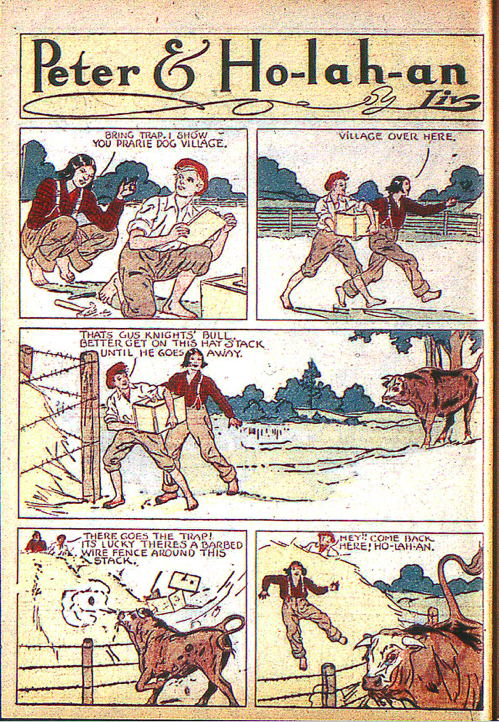
“The Vikings” most likely from a script by MWN with artwork by Livingstone is in classic style with the story at the bottom of each panel and no dialogue. It’s beautifully rendered but the story is a little difficult to follow.
Although the usual sites claim there isn’t much information on Livingstone, there is actually quite a bit even with a cursory search. R.H. (Rolland Howard) Livingstone was born October 29, 1873 in Chicago, Illinois. His father was from Scotland and his mother French Canadian from Nova Scotia. He would have been about 62 years old during the time he contributed to the Major’s magazines. He, like W.M. Allison and others, doesn’t fit the mythic image of young artists creating the comics. In reality there was a mixture of older mature professional artists looking for work during the Depression and young artists just starting out. That’s not a bad combination.
If I’ve connected the dots, Livingstone’s father was a miner and the family moved to San Bernandino, California in 1875 where he grew up. At age 18 he was working as a mail clerk at The Times-Index in San Bernandino. So far, I haven’t been able to find where Livingstone studied but I’m guessing the Chicago Academy of Fine Arts. He seems to be established professionally by 1894 when he was about 21. The 1894 Monthly Illustrator noted that he “has been among the Sierras in California.” Livingstone was obviously taken with the west as his original comics often had western themes such as “Peter and Ho-lah-an” and a number of tales of the gold rush, not surprising given his background.

The 1900 census lists Livingstone as living in Brooklyn with his widowed mother. They moved to Perth Amboy by 1903 and by 1904 he was married to Estelle V. Noe who divorced him in 1909. In the newspaper clipping she is referred to as “identified with newspaper and art work,” whatever that means. There’s evidently quite an untold tale because she soon married a flamboyant theatre producer and it is hinted they were already good friends. In 1910 Livingstone married Lella Parr in Brooklyn and by 1918 they were living in Chicago where he was employed as an artist for Lord & Thomas, the legendary advertising firm. Livingstone must have worked consistently as an illustrator for books and newspapers. In 1907 he illustrated a reprint of Short Stories by Stephen Crane and I found hundreds of syndicated newspaper stories illustrated by him in 1922 and 1923. They were still living in Chicago in 1930 where he continued working as an illustrator and according to the census was employed and owned his home. The 1940 census reveals them to be back in New York, in Manhattan and he lists his occupation as an artist working for the W.P.A.
After his work for the Major, Livingstone appeared in Volume 2, 3 and 4 of The Comics Magazine with a two-page comic “Freaks of Luck” consisting of storylines with a twist at each ending. Unfortunately, some of them are racist depictions. According to Jerry Bails, Livingstone worked out of the Chesler Studio in 1937, the Eisner-Iger Studio in 1939 and the Iger Studio, 1940-1943 during which he illustrated a number of comics. He’s noted for his illustrations for Classics Illustrated. I find his earlier work and especially the original comics he did for the Major as some of his best. Livingstone died in Manhattan, May 11, 1944.
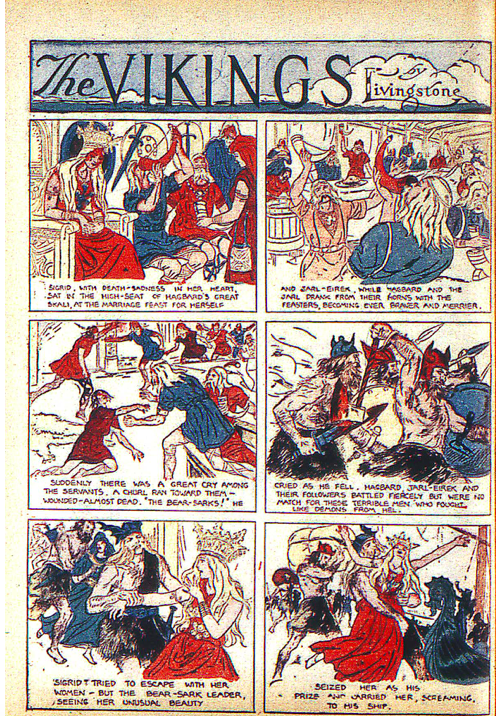
“Ray and Gail on the Trail of Life’s Adventures” by Clem Gretter, two pages in color continues the ongoing story. The artwork is consistently good but the story is a little confusing. It’s not clear who the character Joe Macula is and he now seems to be a central character to the plot. It’s also confusing about the aunt’s illness and her medicine and pills and who is tampering with them and why. Macula attempts to get the treasure map and ends up in a fight with another person. In the last panel they both go over the side into the sea.
Gretter also contributed a page that again appears to be filler as “Guy Hoot’s Reposoir” by “Gretta” in black and white. The title is a peculiar choice. Reposoir is a French word meaning a temporary altar or a place to rest. I doubt many readers of the magazine had ever heard the word much less knew what it meant. It’s a strange page with quite a few odd statements and puzzles that seem to have double meanings as they don’t make sense and they are not amusing. The introduction to the page offers a tale of a showman paying his chorus girls in the middle of the week who then walk out on him to see a movie. It makes no sense to the rest of the page. Does this refer to the Cook/Mahon episode? The first puzzle shows two men on a horse with one man facing the wrong way and pulling the tail of the horse. The caption reads “The boys are having trouble with a crowded plug. Can you find them another horse??” I don’t think this was aimed at the Major because Gretter hung in for the rest of 1936 and into 1937 and did not participate in the 5 issues of The Comics Magazine. It’s definitely a puzzle page.
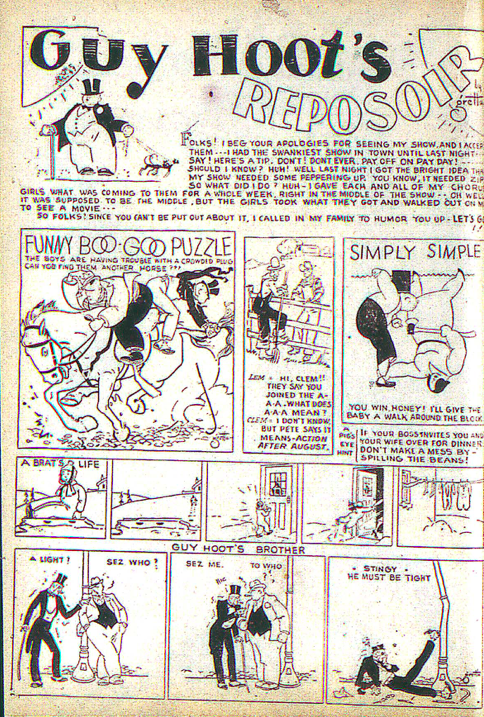
Sheldon Mayer’s “J. Worthington Blimp, Esq.” a two-page comic in color continues the story of Blimp and Jupiter Jones on their way to San Diego. They are unaware the stagecoach they have stolen is valuable and a reward has been posted. The first panel has an unfortunate Italian stereotype. When Blimp and Jones reach Indiana, they are offered money to advertise a movie. Blimp isn’t happy but Jones gladly takes the money. The story is fun, the artwork descriptive and well executed.
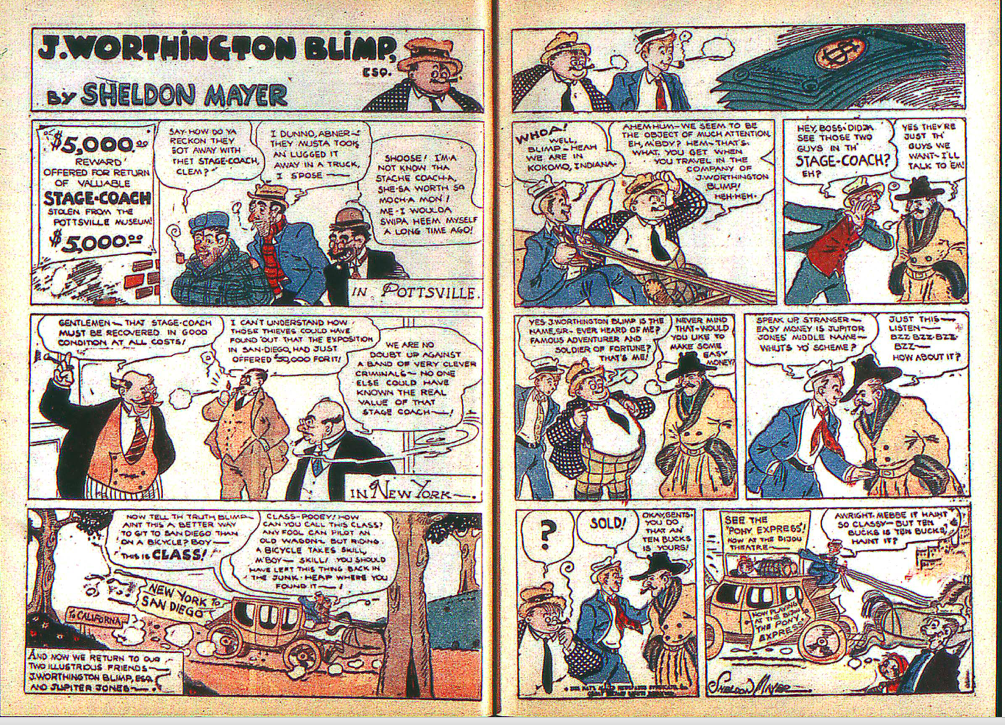
Mayer’s second continuing comic, “The Strange Adventures of Mr. Weed,“ also two pages and in color reveals that Mr. Weed and Mr. Mowcher have succumbed to the arrows of Eros and everyone is in love except young Fritz who by the last panels has also succumbed. The artwork is terrific as usual especially in Mayer’s depiction of his characters emotions, however the storyline seems to have bogged down and isn’t all that interesting. Perhaps it was a theme for Valentine’s day that was suggested rather than his own idea.
Tom Cooper has three continuing stories, all in color. “17-20 on the Black” written by Billy Weston and illustrated by Tom Cooper and “Castaway Island” and “Captain Spiniker.” “17-20 on the Black,” two pages and in color is an intriguing story. Now we know the mysterious woman is Miss Vallen whose pearls have been stolen. Kim the Chinese servant tracks the thief and he and Jim Dale go to the ship where Frog Morton has the pearls. Jim Dale punches one of the thieves. The scenes on the water are especially well-drawn however the figures aren’t Cooper’s best. Although Kim is obviously intelligent he speaks in classic Chinese stereotype.
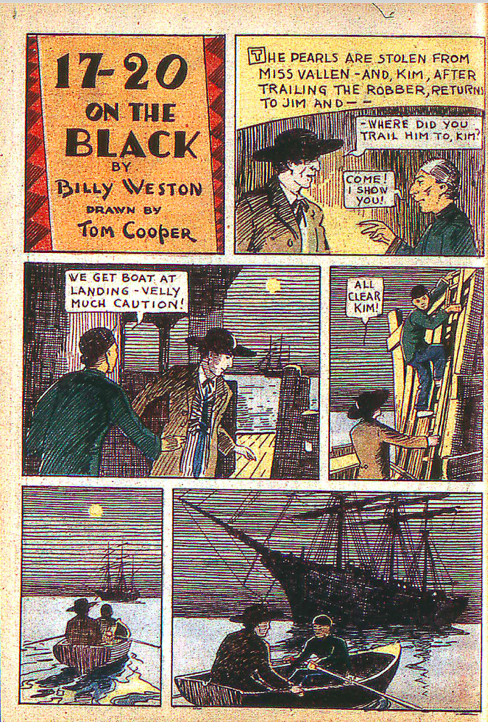
“Castaway Island” by Tom Cooper, two pages and in color is a continuing story. In this episode Larry and Dot end up on an island with a Scotsman by the name of Dougal MacDougald called Mac, which seems kind of jokey. In the last panel, a villain appears with a pistol answering to the name of Blackface. The story isn’t that well plotted and doesn’t move quickly but with the appearance of a villain things might get more lively.
“Captain Spiniker, ” by Tom Cooper, two pages and in color is a continuing character and storyline. It is one of my favorites. The strip consistently has all sorts of sly wordplay references. Spiniker and his sidekick Alaskan Native guy attempt to break out of the brig. They use a pickle barrel and pretend it is full of explosives. They tell Sternpipe they will blow up the ship unless he lets them out. They throw Sternpipe and the first mate in the brig and take over the ship, have a fine meal and smoke cigars on the deck. Unfortunately, the stereotypical black guy is the cook. Captain Sternpipe is furious when he discovers he has been fooled by a pickle barrel. I love this comic with its clever use of words and unique artwork and character depictions.
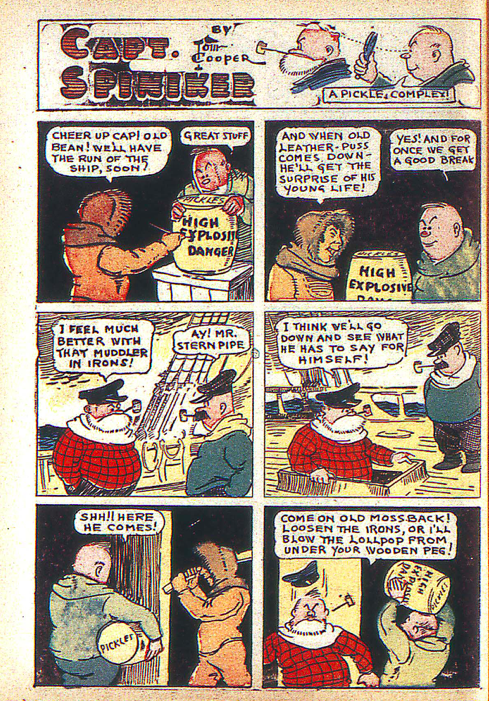
Matt Curzon makes his last appearance in the Major’s comics with his two recurring comics “Dickie Duck” and “Freddie Bell, He Means Well,” both in black and white. Dickie is supposed to put the garbage away but forgets and brings it back. The Farmer thinks it’s something someone sent and opens it to find the garbage. Why he didn’t realize this is a good question. However, he sends Dickie back out with the garbage and this time Dickie throws it in the mailbox. It comes back to the Farmer with postage due and when opened there is the garbage. The last panel shows the Farmer with a gun on Dickie. Curzon’s skill is top-notch and his story-lines are solid and easy to follow.
“Freddie Bell He Means Well” has two pages with this recurring character. The first page shows Freddie listening to a radio show about gangsters and confusing the two adults who think a real holdup is actually happening. The second page is another take on the George Washington I cannot tell a lie tale but it doesn’t end well for Freddie. These are simple one joke comics but done very well.
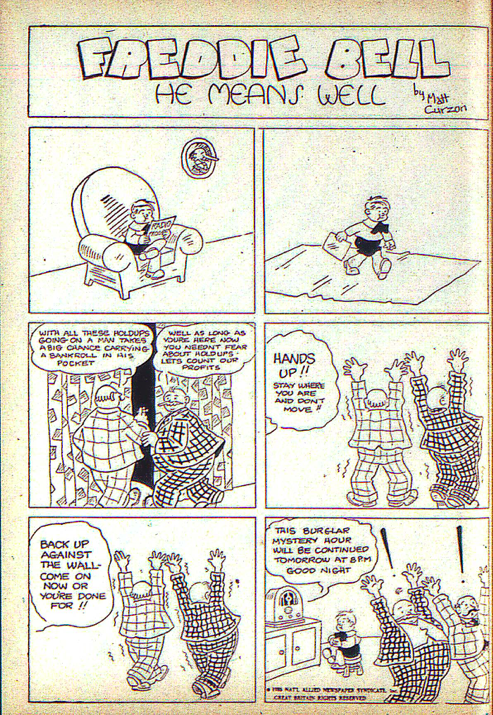
I wasn’t able to find much readily available information on Matt Curzon. According to an entry in Allan Holt’s Stripper’s Guide, one of his relatives claimed that his birth name was Nathan Kurtzon and that he arrived in the US from Minsk in 1903 around the age of 6. I wasn’t able to find any evidence for that. Jerry Bails has his birth as 1905 and his education as Cooper Union and Pratt Institute. On his 1940 WWII draft card Curzon listed his birth as July 10, 1905 and his place of birth as Russia. For employer’s name on the same card he wrote Self. Curzon was one of the artists who “left” the Major’s magazines and contributed to Cook and Mahon’s The Comics Magazine. For The Comics Magazine he brought over “Freddie Bell He Means Well” and “Dickie Duck” although again there is a reference to it being borrowed from New Comics. Dickie Duck made the cover of issue 3 of The Comics Magazine. Curzon seems to have had a prolific career in comics and as an illustrator. He was a member of The National Cartoonists Society so there is probably a good deal more information to be found. He’s most remembered for “The Pixie Puzzle Adventures” that ran from 1948-1956 in the Sunday New York Herald-Tribune. Although no one seems to have noticed, that feature originated in New Comics #1. Curzon died June 9, 1975 in Brooklyn, New York.
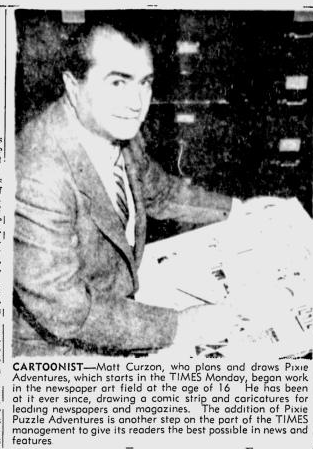
Beaver Valley Times, January 9, 1951
The non-fiction section of the magazine has several photos that appear on various pages that don’t relate to the text. Most likely these were promotional pieces and helped to fill space. There is a photo of Victor McLagen, the boxing champ of Canada starring in The Professional Soldier and on the opposite page, a terrific photo of Eddie Duchin and the Nicholas Brothers. If you haven’t seen the Nicholas Brothers in action in one of the films they’re featured in, do yourself a favor!
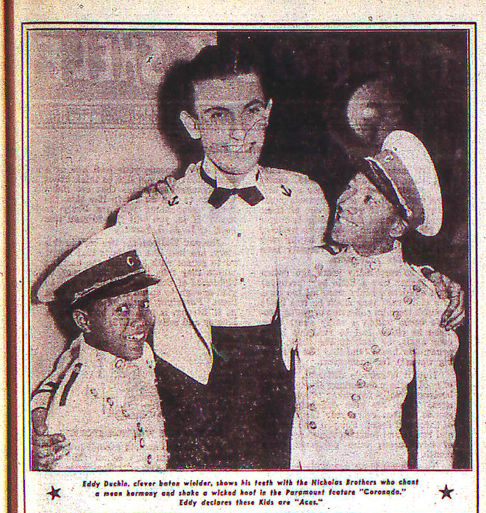
“The Book Shelf” by Carson Smith (McCullers), a continuing feature is two pages with not so great illustrations by Bill Cook. I usually have to slog through these pages but already Carson Smith’s (McCullers) ability to capture the reader is evident. She writes much more directly to the reader than previous writers of the feature and instead of it coming across as generic you feel that she is interested in you. Her synopses of the books are such you want to read them. One particular book is noteworthy for the times—“Adventuring in Palestine”—a story of two girls from Germany who are sent to live with their relations in Palestine.
A continuing feature, “It’s Magic” by Andrini, the Great, whoever that is, offers how to on magic tricks. They are all simple to perform. The rudimentary illustrations are by Bill Cook.
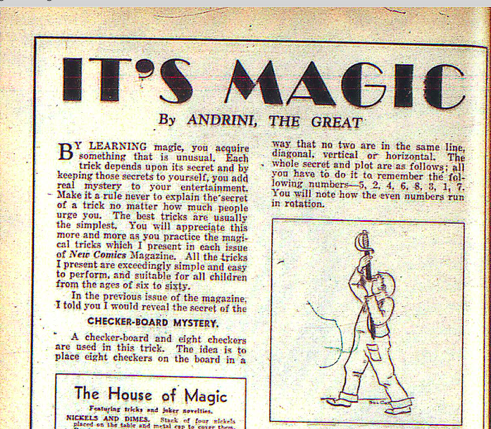
“Hobbies” another continuing feature suggests in the headline that “Every-Man, Woman, Boy and Girl should have a hobby or two.” Once again there is no byline but an introduction of Danny Ryan by the editor, about whom we are told, is there to answer questions on hobbies. Forgive me, it is a super boring explanation of leatherwork projects with drawings and photos of tools needed. Mr. Ryan also offers to send the entire kit needed for $.35 and a catalog as well just in case you’re in the market for such.
“The Radio Dialer,” an article by A. R. Lane is two pages of what is mostly press about recent radio shows. The only person I knew of was Jimmy Durante. All the shows were on NBC WJZ network so they obviously supplied the text. A large photo of Lanny Ross and John McIntyre from Showboat is on the second page and has no relation to the text.
“Worthwhile Films to Watch For” is a two -page article with no byline. The illustration looks like it might be the one created by Dick Loderer. There is a photo of Baby Leroy and Virginia Paxton but neither are mentioned in the article. The Invisible Ray with Boris Karloff and Bela Lugosi, Our Gang, Buck Jones and Lily Pons latest films are discussed. There is a great anecdote about Myrna Loy snowbound at her cabin in the San Bernandino Mountains driving down in second gear to get back to LA in time for filming with Spencer Tracy on Whipsaw. The articles are usually together near the center of the magazine for obvious printing and binding reasons.
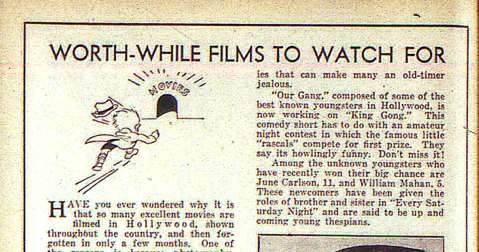
Now back to comics! “Chikko Chakko” two-pages in color by Ellis Edwards features his continuing character. Each page has a short tale. The first page shows Chikko attempting to get his car going by putting a bull’s head on it and acting as a toreador. In return the car acts like a bull and chases him. In the second story Chikko flatters his girlfriend Loopie’s parents and then does the same to Loopie but all he really wants is for her to wash his shirt. She promptly throws him out. Loopie comes across as appealing and well able to take care of herself. Although Chikko is drawn as a character, it’s not overly exaggerated and no one is drawn in an unflattering manner. Chikko is likeable and I look forward to see what his latest antic will be.
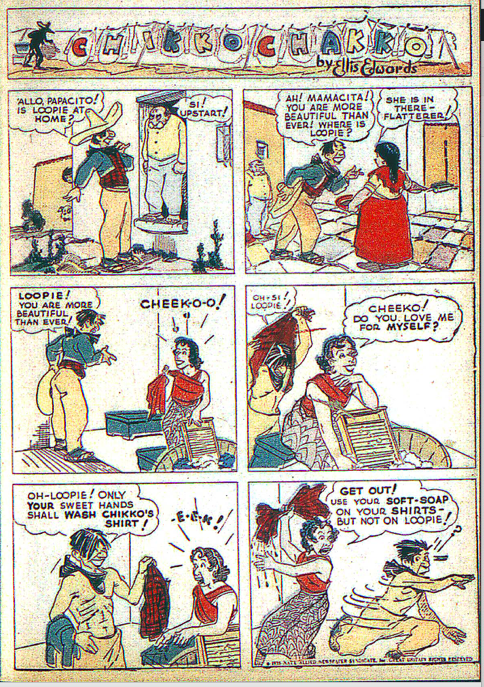
“King Arthur” has four pages in black and white and this is another example of what I believe were pages to fill. There is no artist’s signature that I can see although the GCD attributes it to Rafael Astarita as does Jerry Bails. The strip is in the classic format with the story at the bottom of each panel. There are a lot of versions of this myth and this one isn’t attributed to an author. The names are not the usual anglicized spellings and the story is a little hard to follow.
“Dare Devil Dunk” appears in two pages in black and white by Stan Randall. It’s a continuation of the character that first appeared in New Comics #2. He’s much more interesting in this episode. We discover he is a stunt man for the movies and can’t get a job—an ongoing theme in many of these Depression era comics. However, Dare Devil Dunk uses his stunt skills to help others. He saves a little boy and a puppy. The intention is good but the child is drawn as a typical stereotype of black people. Dunk’s manager tells him he can’t keep doing things for free. When the manager falls down a manhole Dunk reminds him he’s not supposed to do anything for free. Dunk’s a likeable character and we want to see what happens next. The artwork is typical of the style of the period.
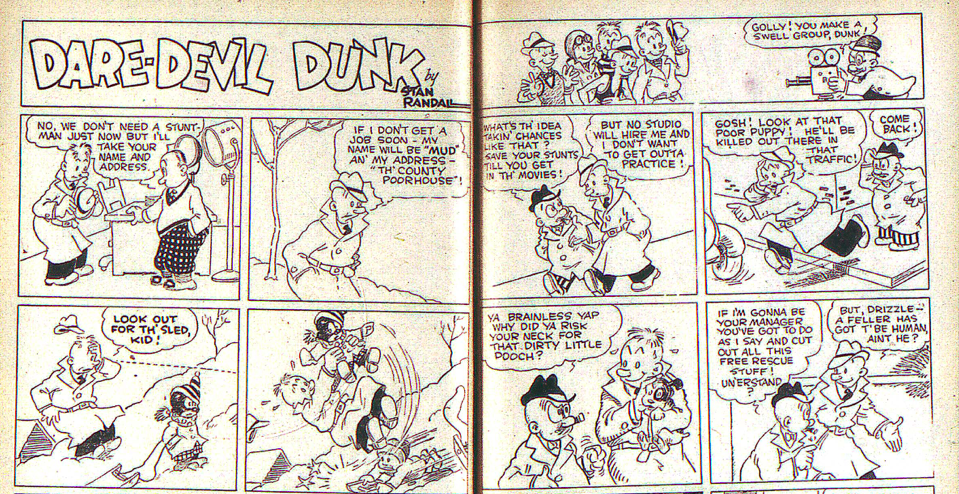
As “Randall” Stanley Randall also contributed the “Cartoon Corner,” one page in black and white of a cartoon lesson labelled Lesson 3 Hands and Feet.
“Just Suppose” a regular feature by H.C. and A. D. Kiefer is two pages of art and text in black and white. This time we suppose that Harold, Saxon King of England granted his brother land in England and they would have driven out the Normans and there would have been no English Navy. The other suppose is bizarre. Apparently, Robert E. Lee’s mother was not dead when interred in the family vault, was rescued and thus a year later Robert E. Lee was born. A search turned up several newspaper items that indeed corroborated the story.

My guess is that Aline D. Kiefer is the writer for these as Bails lists Kiefer as an artist but not for scripts. She did write a children’s book that H. C. Kiefer illustrated. It makes me wonder if she also wrote the scripts for “Wing Hardy.” Although the Digital Comics Museum lists her as the writer and artist for a biography of Louis Pasteur for Funny Picture Stories October 1937, I believe that is incorrect. It is most likely Henry Carl Kiefer who did the illustrations and Marie Aline who wrote the text even though it is signed DeKerosett. It looks similar to the “Just Suppose” feature and H.C. used Marie Aline’s maiden name in his first comics for the Major.
John Patterson contributed his last two comics—both new—to the Major’s magazines in New Comics #3 and made his way over to The Comics Magazine. “King Bozo” a one-page comic in black and white, gives us King Bozo who decides to save money by cooking rather than having someone else do it. However, he has no idea what to do and calls the Queen long distance running up an enormous long-distance bill. The comic has a negative stereotyped native black man calling him boss who is actually the smarter person.
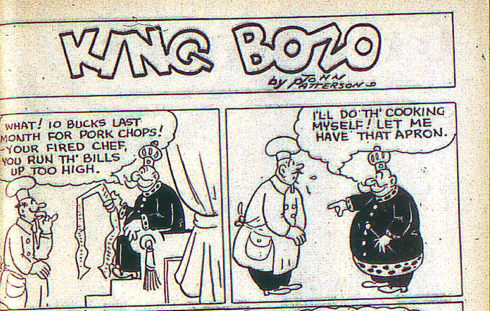
“Luke McCluke The Fireman” also by John Patterson is a one-page comic in black and white. Luke is also a new character but not very likeable. He seems bored and isn’t all that interested in saving a house on fire until he finds out it’s next to the ballpark.
Patterson’s continuing comic “Skipper Hanks” became “Skipper Ham Shanks” for The Comics Magazine. Other than the comics he did for the Major and Centaur from 1935-1939 I wasn’t able to find any other information on John Patterson. Given the generic name it’s almost impossible without a few hints or clues. Jerry Bails had no bio information and Lambiek doesn’t even list him. It’s possible John Patterson wasn’t his real name. I’m not giving up but he’ll have to go into the mysteries file for now.
“Court Chuckles” by Maxwell in black and white looks like another filler page. It’s the only appearance by “Maxwell” in the Major’s magazines. There are several single panels on one page featuring jokes with court themes. The artwork is solid and the jokes are well-done. In searching for the identity of “Maxwell” I discovered it was none other than Samuel Maxwell Iger. It’s an interesting contribution to the magazine and I’m wondering how it came about.
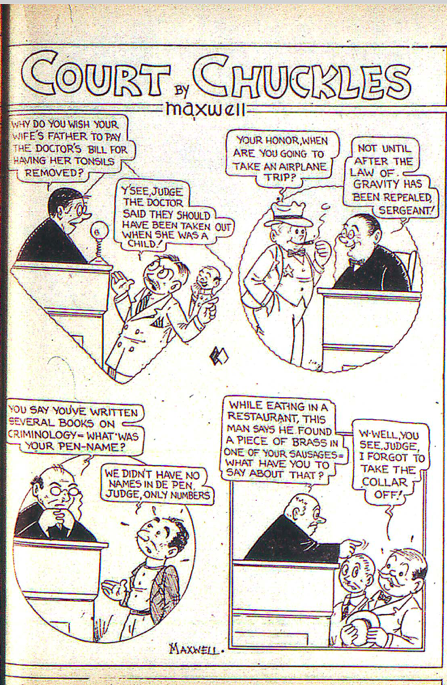
“Sara Lou Sunshine” by Emma McKean, a two-page comic in black and white is written in rhyme. It’s obviously aimed for small children. The artwork is simple but clear. The theme is decidedly Depression era with Sara being a good girl and helping other children who need clothes and food. It continues in New Comics #4 making Emma McKean the first woman to have a continuing strip in DC Comics.

“Wing Walker” by Thor in black and white is a continuing four-page comic. I find the story confusing. Somehow the damsel in distress is on one of the planes of the gangsters along with one of the Seminoles. She comes out of her hiding place and Tyee attempts to grab her. She knocks him out with a fire extinguisher. Wing persuades the chief to let him go so he can fly the plane and rescue the girl. He manages to get to the plane in a hail of bullets. All the action scenes show his ability as a pilot. Why she has been kidnapped isn’t clear. We’re told that “The Thrill comes with the Next Issue.” I’m still searching for the identity of Thor.
“Needles” by Al Stahl, “Needles Uses His Noodle!” is two-pages in color of a continuing character. In this episode Needles decides he will invent a way for a flower pot to be secure in case of falling. He ends up creating what turns out to be a sling shot that bonks him on the head. It’s silly but entertaining and the artwork is distinctive.
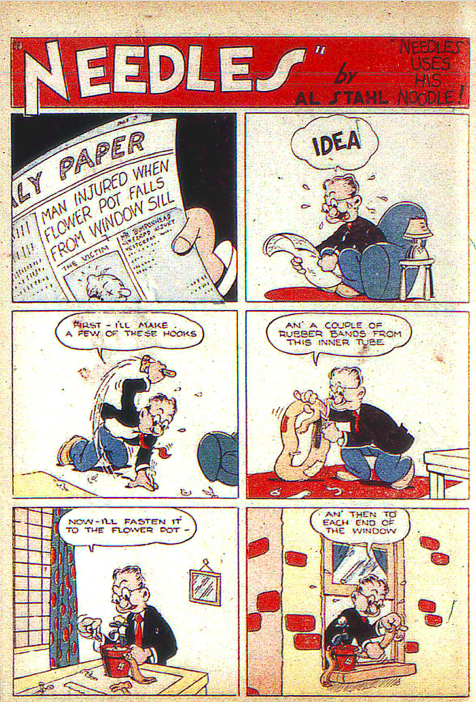
The last comic in the magazine is one of the best—”Federal Men,” a continuing comic by Siegel and Shuster from the Major’s concept. It’s four pages in color. This episode finds Steve Carson guarding a character named Brent from someone attempting to kill him because of stolen plans. It’s a great script with lots of exciting action and the artwork is some of Shuster’s best. A plane is pursuing Carson and Brent. After a fight in the sky with Steve jumping on the other plane, he and the pilot, Grayson, parachute to the ground. It turns out that Brent is the bad guy who stole Grayson’s plans. Grayson is angry and says “I’ll kill the –” Steve replies, “No you won’t Grayson. The US Government will take care of your revenge—in court.” Would that it were so. The last panel is an offer to send drawings of Steve Carson to the fan that writes the best letter. Wouldn’t you love to be the recipient of one of those!
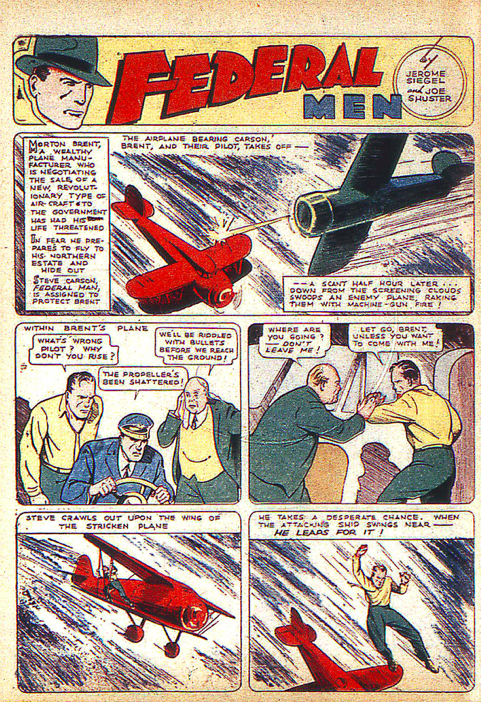
Things are changing with the Major’s magazines, there are obvious financial issues but the magazines are evolving creatively against the background of coming competition from The Comics Magazine. We’ll see what happens next when More Fun #9 hits the newsstands.
With much thanks I received help from and purloined from: AskArt, Jerry Bails Who’s Who, Comic Books Plus, Digital Comics Museum, The FictionMags Index, Grand Comics Database, Doc DC, Allan Holt’s Stripper’s Guide, Alex Jay, Lambiek Comiclopedia, William Patrick Murray, David Saunders and Carol Tilly as well as the stalwart MWN group.
